What's the difference between a bowl lift and a tilt head stand mixer? Bakers and patissiers explain
I'm baking down the great stand mixer debate
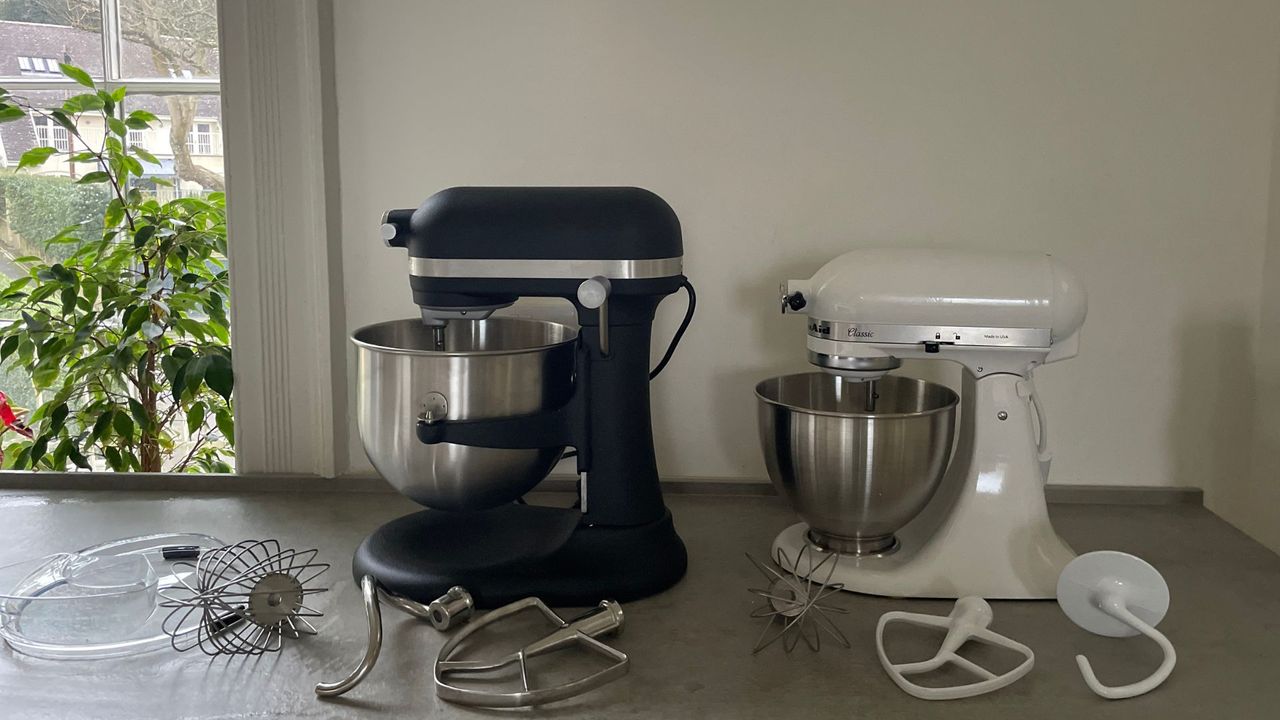

Choosing the right stand mixer for you largely boils down to one fundamental design choice: bowl-lift vs tilt-head. Whilst these two types of stand mixers look very similar, they’re designed to suit different bakers. So, the choice is yours and you need to make it carefully.
Just a quick Google search of 'bowl-lift vs tilt-head stand mixer' will bring up passionate responses from bakers, pâtissiers, and enthusiastic home bakers. Everyone thinks that theirs is the best stand mixer, which isn't very helpful when you're trying to get some balance. That's where I (and my qualified baker and pastry chef friends) come in.
I've quite literally tested these side by side. I've used them both to make cakes, whip cream, and knead dough. I've brought all the facts and evidence together to bring you a balanced breakdown of how to choose between the two. The proof is in the pudding (and in my pictures).
What is a bowl-lift stand mixer?
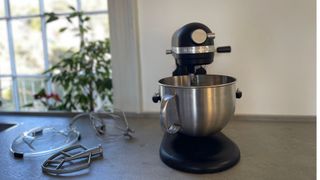
I'll make life easy for you. Bowl-lift stand mixers are for serious, seasoned bakers. They're heavier, more expensive, and often bigger than tilt-head stand mixers. The only reason you'd embrace these potential drawbacks is because they offer some really useful flourishes.
The first useful feature to note is that the weighted base makes it more stable. Making your stand mixer heavier on the bottom and taking away the destabilising tilt-head is essential when you're working with lower-hydration doughs and mixes. Adriano Zumbo, world-renowned Pâtissier and founder of Zumbo explains "with a tilt head mixer, the bowl is fixed in position and has no ability to compensate for mix size and firmness. On the other hand, with the bowl lift stand mixer you get more balance and give in the whole process. That's why you'll find it in the kitchens of avid bakers or small businesses."

You'll recognise Adriano Zumbo's name. As one of the world's most renowned pastry chefs, he's everywhere. Zumbo rose to fame on MasterChef Australia and then became a global sensation through Netflix hits Zumbo’s Just Desserts and Sugar Rush. Zumbo has opened a drool-worthy array of pastry shops, published best-selling cookbooks, and collaborated with major brands like Arnott’s Tim Tams.
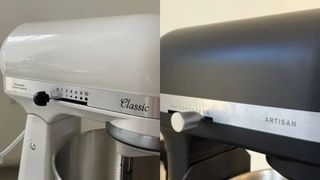
You'll also get more nuanced controls on your bowl-lift stand mixer. Brands know that they're catering to serious bakers, so they'll give you half-speed, hand-folding settings as well as smaller increments between them. KitchenAid is a great example here: their bowl-lift stand mixers have eleven-speed settings (from a half-speed through to ten), whereas their bowl-lift models increase speed in increments of two.
Finally, it won't surprise you to know that bowl-lift stand mixers usually come with more accessories compared to tilt-head mixers. It's the same story as you've seen above. Brands know they've got creative, ambitious bakers buying these stand mixers, so they'll offer another type of beater, a different dough attachment, or perhaps something completely different.
Sign up for the woman&home newsletter
Sign up to our free daily email for the latest royal and entertainment news, interesting opinion, expert advice on styling and beauty trends, and no-nonsense guides to the health and wellness questions you want answered.
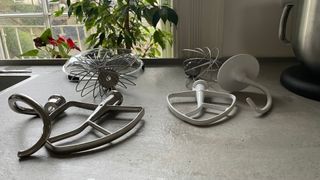
This is a comparison of the accessories that come with a tilt-head KitchenAid stand mixer (right) and bowl-lift (left). You'll also get a flex-edge beater with the bowl-lift KitchenAid.
As you can imagine, this means that bowl lift stand mixers tend to be more expensive. It’s a self-fulfilling prophecy that has led to this design becoming bigger, more powerful, and more advanced.
In summary, a bowl-lift stand mixer is ideal if you bake a lot of bread and need a lot of capacity. I've popped three suggestions for the best bowl-lift stand mixers that you can buy below. If you’re a simple home cook, there are other options for you cruming up.
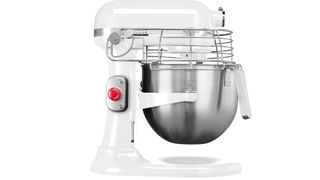
The Professional means business, as you can tell. The baseball cap-style cover is an extra safety option for commercial environments. It's NSF-certified, with the most powerful motor (1.3 HP) that KitchenAid makes running it.
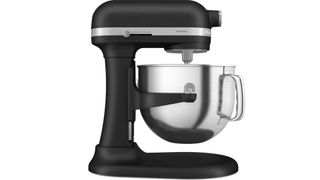
This is the biggest domestic stand mixer that KitchenAid makes. It's part of their Artisan range, so the motor churns out 325 watts from the robust, stainless steel motor.
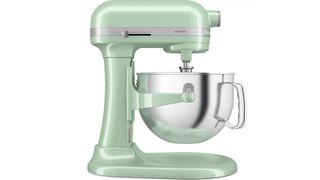
This is almost identical to the one next door, except that the bowl is a litre smaller. This means it makes 12 less cookies (that's still 60) and a couple less pizza bases in one go.
What is a tilt-head stand mixer?
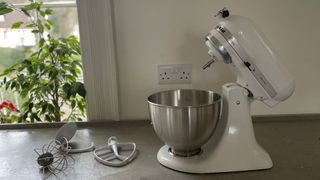
You’ll recognise tilt-head stand mixers well. Debra Clark, Recipe Developer and Founder of Bowl Me Over, says "Tilt-head mixers are the ones you’ve probably seen in most home kitchens. The head of the mixer tilts back, which makes it super easy to add ingredients or swap out attachments. This design is perfect for casual bakers or anyone who’s mixing smaller batches. They’re usually lighter, take up less counter space, and are great for things like cookies, cakes, and occasional bread doughs. Plus, they’re just so convenient when you’re in the middle of a recipe and need to toss in that forgotten splash of vanilla or scrape down the bowl."

Debra has been a recipe developer and food photographer for over thirty years, so you can guarantee that she's seen her fair share of stand mixers. She's a seasoned baker and recommends the KitchenAid Professional 600 Series, if you want a bowl-lift stand mixer.
Lots of people tiptoe around the tilt-head mechanism and, whilst I've been saying that bowl-lift models are more stable, tipping the head of one of these back doesn't jeopardise the balance of your stand mixer. In fact, it's very simple and easy to use, whether it's your first time or your fiftieth cake.
If you’ve done some shopping, you’ll know that it’s the preferred mechanism for Smeg, Kenwood, and KitchenAid's stand mixers, which is a testament to the tilt-head design in itself. It's also the type of stand mixer that they use on The Great British Bake Off, so don't go thinking these are crude or rudimentary. As with the bowl-lift stand mixers, I have some favourites. And they're not all KitchenAids this time.
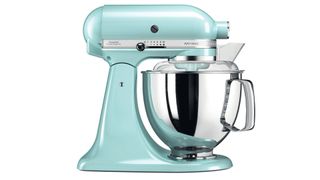
Possibly the most iconic stand mixer of all time, this comes in 39 different colours. You'll get the standard accessories as well as a splash guard too. It's stylish, powerful, and a dream to use.
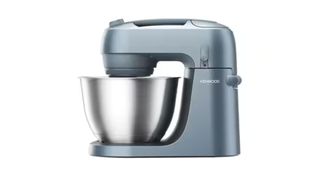
The Go is brand new to the market and it's a space-saving hero. There's a neat handle on top and the whole stand mixer is only 30cm tall, but it can still boast an impressive 4L capacity.
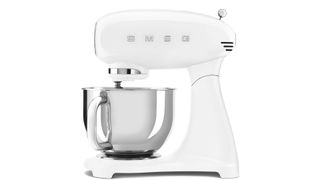
Cheaper than a KitchenAid and just as beautiful, the Smeg is a retro option for the style-conscious. It can be a little noisier than others, but I think that's a compromise worth making.
Head to head

The bowl-lift is on the left and the tilt-head is on the right. You can see that the bowl-lift has done a really clean job of kneading the dough.
You get the idea about the kinds of customers stand mixer designers are thinking of when they're making each model. Of course, the mechanisms are different, but what does that look like in real life?
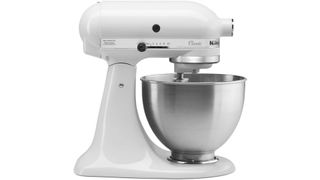
For
- Lighter and more compact
- More widely available
- Mechanisms are easier to use
- Often cheaper
Against
- Lacks sophistication for advanced bakers

For
- Bigger capacity
- More power makes them more versatile
- More stable thanks to weight
Against
- Overkill for the average baker
In spite of all their differences, if you step back, these are both stand mixers that can whip, mix, and bake. Rena Awada, Owner and Head Chef at Healthy Fitness Meals, says "I'd happily make plenty of use out of both stand mixers in my kitchen. They both whip, knead, and mix better than anyone could by hand."

Rena Awada is the Owner and Head Chef of Healthy Fitness Meals. Her food blog features delicious, healthy, family-friendly recipes made with real food. She recommends checking out KitchenAid or Kenwood if you want to find a really good stand mixer.
Are there any other types of stand mixers?
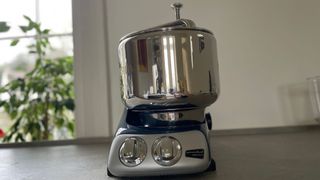
Of course, stand mixers aren’t limited to bowl-lift and tilt-head functions; they come in all shapes and sizes. The alternative that you’re likely to come across is a bowl spinning stand mixer.
Again, this favours bread makers, because it can put more power through the motor and more weight in the base, keeping it stable as your bakes get thicker and tougher. The best example that I have is the Ankasarum, which is a favourite amongst bread bakers. It’s complex and comes with lots of extra accessories, but that’s just some of the reasons that it’s been such a success within the community.
The differences between a KitchenAid Bowl-Lift and Tilt-Head stand mixer
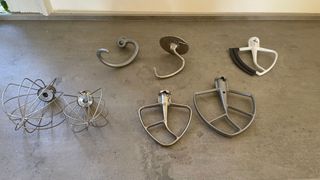
The bigger accessories (as well as the white flex-edge beater) are the ones that come with the tilt-head stand mixer.
Inside the bowl-lift vs tilt-head stand mixer debate, there's another question. How do the KitchenAid models compare? KitchenAid has the biggest range of bowl lift stand mixers, so it’s quite likely that you’re tossing up which one to go for out of bowl lift and stand mixers. There are lots of differences between the two, in a very generic sense, that I’ve described above.
KitchenAid's bowl-lift stand mixers come in 5.6L or 6.6L capacities, which means that you can make up to 72 cupcakes in their biggest model. In the tilt-head stand mixers, the biggest capacity you'll be able to find if 4.8L, which offers you enough space for 48 cupcakes. That's more than I'd be taking to a bake sale, or stacking up for a birthday cake, so don't be alarmed if the number looks small in comparison.
I mentioned above that the speed settings are slightly different. KitchenAid has just launched a half-speed setting, which mimics hand-folding ingredients. You won't find this, or the one-speed increments on their tilt-head models. Instead, the tilt-head jumps up speeds by factors of two. That might sound like a lot, but before I used a bowl-lift, I was in blissful ignorance of the nuances and never felt that I needed them. Of course, it's nice to have a little more control, but it's not a necessity.
Which one should you get?

I know you want me to answer for you, without appraising your kitchen and your baking skills (a cup of tea and a slice of cake is obligatory when I do this), I can't tell you which you need. Think about what you like to bake and how often, how complex your bakes are. For most people, the answer will be a tilt-head stand mixer. However, for the aspiring Mary Berrys and Paul Hollywoods of the world, consider a bowl-lift stand mixer.
FAQs

Is a bowl-lift or a tilt-head stand mixer better?
There isn't really a 'better' model in the bowl-lift vs tilt-head stand mixer debate, just answers which tell you what's better for some. Tilt-head stand mixers are the styles that I'd recommend to the average home baker. These are easy to use and powerful enough to get good results on cupcakes, bread doughs, and whipped cream. The bowl-lift stand mixers are better suited to serious bakers who need capacity and power.
What is the point in a bowl-lift stand mixer?
Lots of people ask this question in the bowl-lift vs tilt-head stand mixer debate. KitchenAid says that they created bowl-lift stand mixers to offer more capacity, speeds, and to give the "extra oomph for very thick or heavy mixtures". They're really the stand mixers that bakers and professionals love.

Laura is woman&home's eCommerce editor, in charge of testing, reviewing and creating buying guides for the Homes section, so you'll usually see her testing everything from the best dehumidifiers to sizing up the latest Le Cruset pot. Previously, she was eCommerce editor at Homes & Gardens magazine, where she specialised in covering coffee and product content, looking for pieces tailored for timelessness. The secret to her heart is both simplicity and quality. She is also a qualified Master Perfumer and holds an English degree from Oxford University. Her first editorial job was as Fashion writer for The White Company.
-
 What is pink mould and how can you get rid of it safely? Experts share advice
What is pink mould and how can you get rid of it safely? Experts share adviceWhile you may not have even heard of pink mould, it's relatively common and important to know how to tackle it quickly
By Emily Smith Published
-
 The White Company's Hypoallergenic Mattress Topper is surprisingly affordable and a dream to sleep on
The White Company's Hypoallergenic Mattress Topper is surprisingly affordable and a dream to sleep onThe The White Company Hypoallergenic Comfort Topper offers a gentle, supportive layer to your sleep set-up for a surprisingly affordable price.
By Laura Honey Published